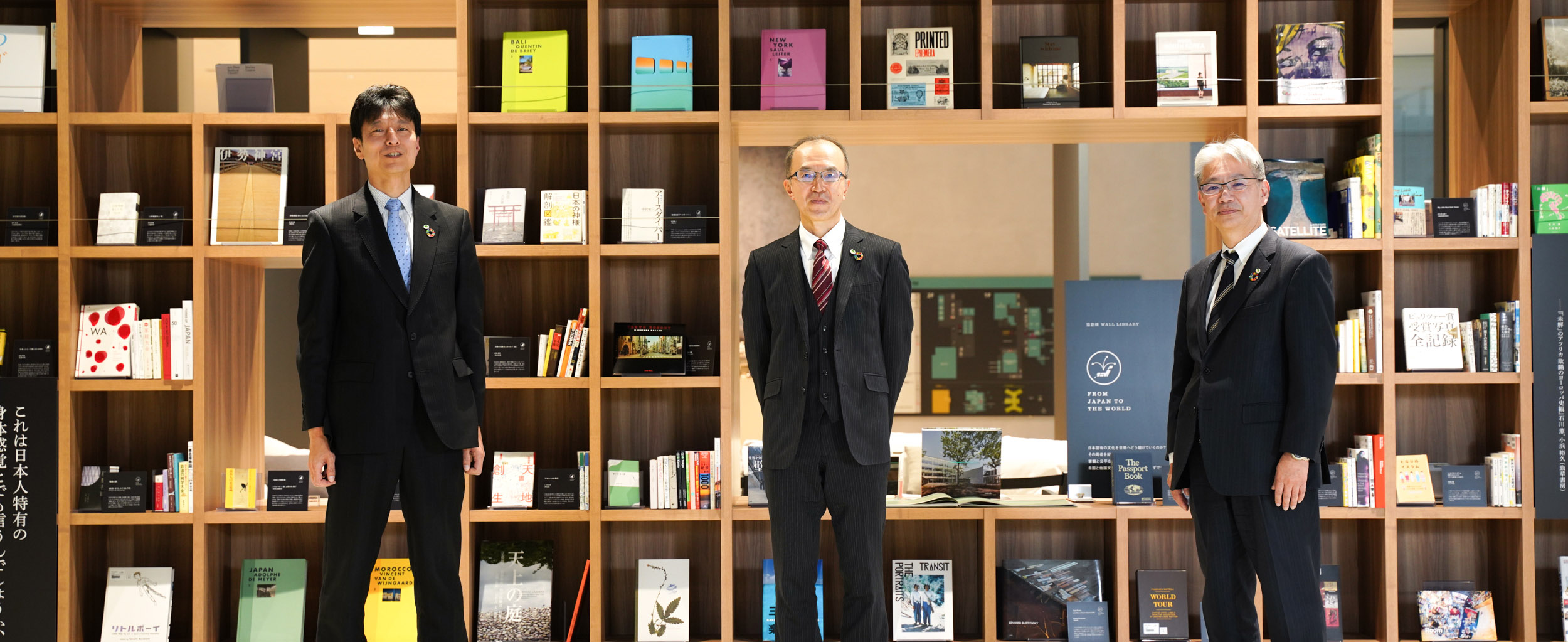
Tucked away in a forest consisting of more than 30,000 trees, the Central Research Laboratory of Hitachi, Ltd. boasts unexpectedly quiet surroundings, despite its location in Kokubunji City, not far from the heart of Tokyo. The laboratory complex was built 80 years ago in a way that honored wishes of Namihei ODAIRA (1874—1951), the founder and first president of the company. “Plan to build a laboratory while preserving beautiful trees on the grounds, instead of cutting them down,” Odaira said. A spring originating from the Nogawa River has also been preserved to complete the landscape.
In April 2019, Hitachi opened a facility called “Kyōsō-no-Mori” (literally translated as “forest of collaborative innovation”) on the laboratory premises, after more than four years of preparations since the initial concept design. The facility aspires to become an innovation incubator that will contribute to building a sustainable society. Designed to encourage collaborative innovation, the Kyōsō-no-Mori started functioning as an open forum where collaboration partners gathered together and shared their visions in an attempt to solve social problems. In-person events and gatherings, however, have become increasingly difficult due to the COVID-19 outbreak.
Given these circumstances, Hitachi has begun the process of digitally upgrading the Kyōsō-no-Mori. Itaru Nishizawa, Shinji Nishimura, and Masakatsu Mori are three members of the laboratory management spearheading the effort. Here is an excerpt from an interview with them on future developments of Kyōsō-no-Mori.
---- Could you briefly describe the main roles of your organization?
Nishizawa:I work at the Center for Technology Innovation (CTI), and the major objective of the organization is to support Hitachi’s social innovation initiatives with its technological capabilities. CTI as a whole covers a wide range of fields contributing to the company’s business, and in particular, the Central Research Laboratory I oversee focuses on three areas: AI, digital technology, measurement and electronics. Since its inception 80 years ago, the Central Research Laboratory has spawned a number of business opportunities through the development of products such as computers, semiconductors, and electron microscopes. Taking advantage of our strong expertise accumulated over the years, we continue building technology platform to produce our products, solutions and services.
Nishimura:CER (the Center for Exploratory Research) has a 30-year history and aims to build the next pillars of technology for Hitachi. The most important role of CER is to explore and develop technology seeds in the areas of information science, life science, environmental science, and basic physics. We work closely with scientific research institutions at universities, so that those seeds can be turned into commercialized solutions to social problems. We are currently engaged in research on next-generation technologies such as quantum computing, iPS cells for regenerative medicine, and hydrogen energy, to name a few.
Mori:My organization is CSI, which is an acronym for the Center for Social Innovation, but the official name is the Global Center for Social Innovation, meaning it has an international presence. There are five sites across the globe, namely, the Japan Center here in Kokubunji, and centers in China, the US, Singapore/India (APAC), and Europe.
“Co-Creation” (with our customers) is the word which best describes our main activities. Collaborative innovation in the past focused on solving specific problems, but nowadays our customers themselves tend to have difficulty figuring out what their real problems are. So, Co-Creation in this context means working together with our customers from an early stage in order to identify their problems and issues. One of the most distinctive characteristics of the CSI workplace is that engineers are collaborating with designers.
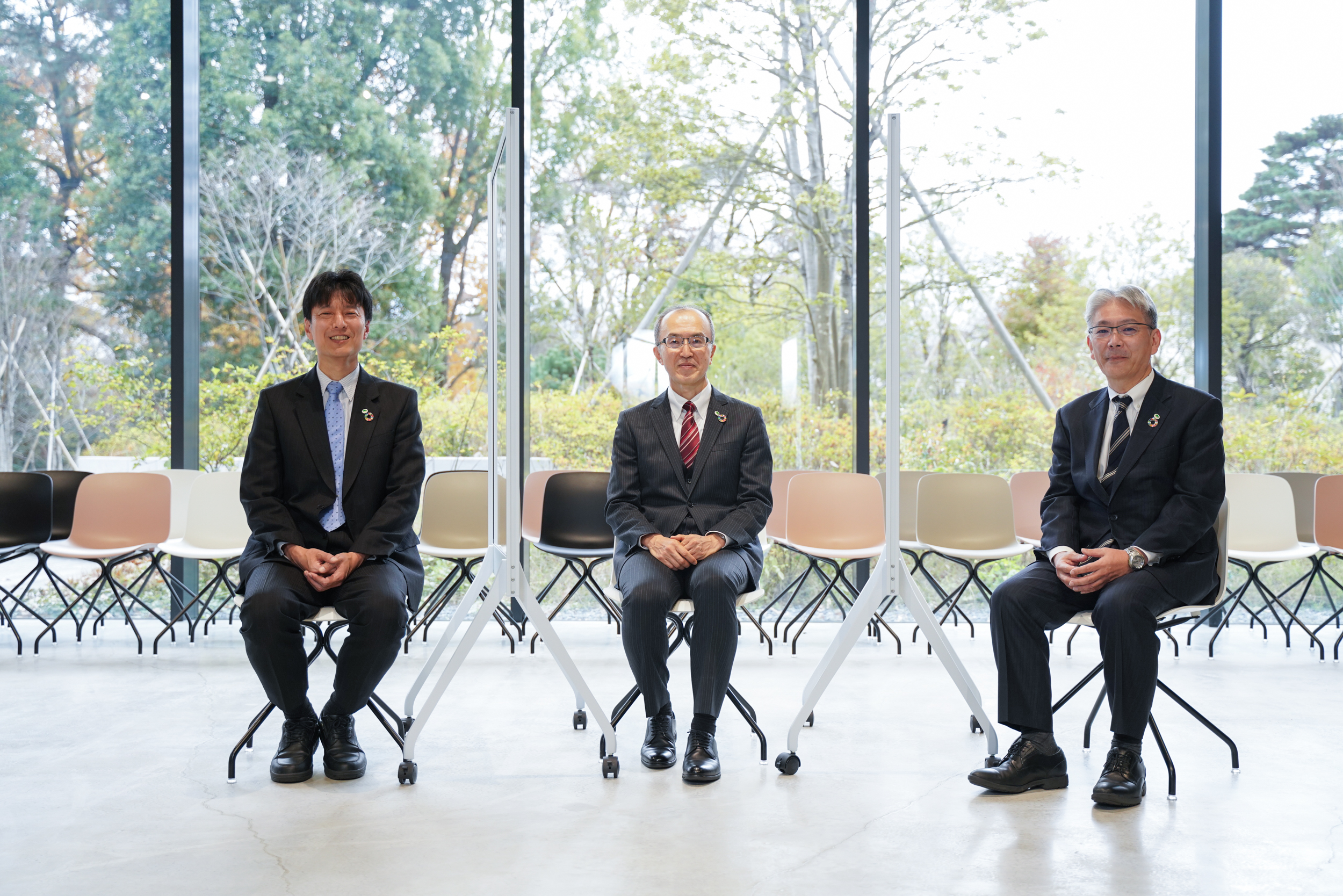 Masakatsu Mori (left), Itaru Nishizawa (center), and Shinji Nishimura (right). The interview was conducted at Kyōsō-no-Mori in December 2020.
Masakatsu Mori (left), Itaru Nishizawa (center), and Shinji Nishimura (right). The interview was conducted at Kyōsō-no-Mori in December 2020.
Nishimura:CSI has a lot of non-engineer employees, doesn’t it? There are people with a psychology background, those who majored in anthropology, and art college graduates as well.
Mori:Hitachi believes that innovation requires a multi-faceted approach, so the company has taken up “design” as one of its research topics and has been studying it for nearly 70 years. By combining design concepts and technologies developed by researchers, we continue encouraging innovation while collaborating with our customers.
---- In April 2019 Kyōsō-no-Mori was established here on the premises of the Central Research Laboratory. Tell us about your activities so far.
Nishizawa:More than 8,000 customers visited Kyōsō-no-Mori in FY 2019. In an effort to promote open innovation, we have signed contracts with 18 partner organizations including Kokubunji City, Tokyo. Upon conclusion of a contract, we start working on conceptual design and prototyping of specific products or services. A project team is formed, and a project room is available for their activities. In FY2019, four research topics were explored as projects, out of which two project deliverables moved on to the commercialization stage.
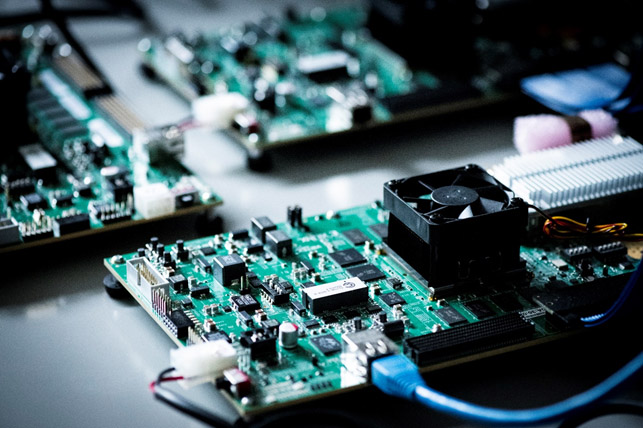 A commercialized service utilizing CMOS annealing technology (photo).
A commercialized service utilizing CMOS annealing technology (photo).
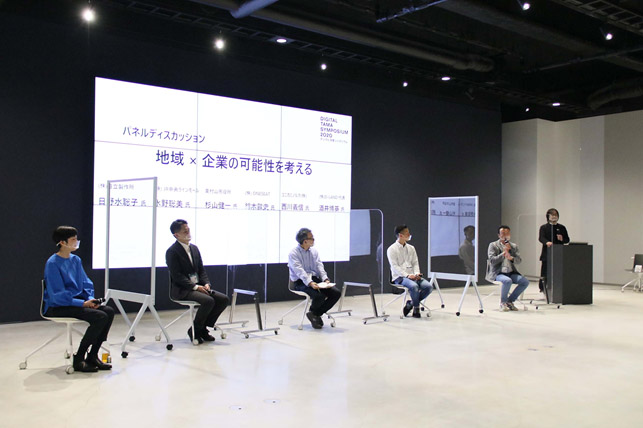 “Digital Tama Symposium 2020 in Kokubunji” organized by a project team in collaboration with Kokubunji City.
“Digital Tama Symposium 2020 in Kokubunji” organized by a project team in collaboration with Kokubunji City.
In April 2020, business units and our laboratory worked together to establish Lumada Data Science Lab. within the Kyōsō-no-Mori facilities. The new laboratory consists of about 100 people including data scientists, AI/data analytics researchers, operational technology engineers and consultants, creating solutions to issues faced by our customers.
The number of our projects increased to nine by the beginning of FY2020, but as we were pursuing collaborative innovation activities*, COVID-19 began spreading widely.
*Case study:
Hitachi sets up a local 5G test environment where it demonstrates highly reliable edge computing operation technology for social infrastructure
---- The COVID-19 pandemic has changed our lives dramatically. We hear that Hitachi has shifted to a new work style companywide, adopting teleworking as a standard practice.
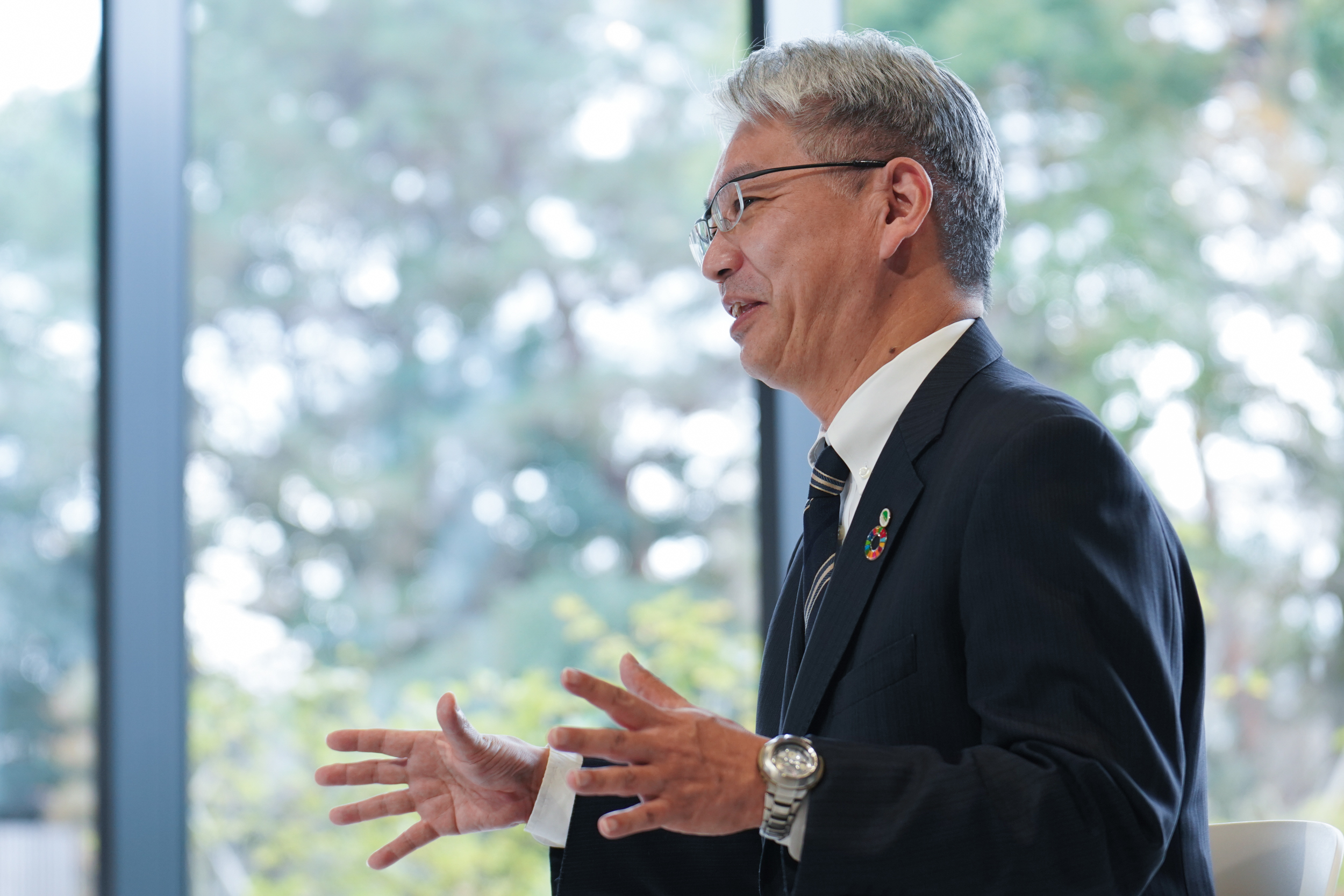
Nishimura:Remote working has taken root and become part of our workplace culture. In July 2020 Hitachi completed the acquisition of the power grid business that had been carved out from ABB Ltd. of Switzerland, and established Hitachi ABB Power Grids. Now our staff here are interacting online with HAPG staff in Europe. Barriers such as national borders and organizations are beginning to fade away, which makes it easier for us to connect with a wide range of people.
Nishizawa:While most boundaries are blurring, we are still facing some challenges; one of them is to make virtual communication more comfortable, with minimum stress.
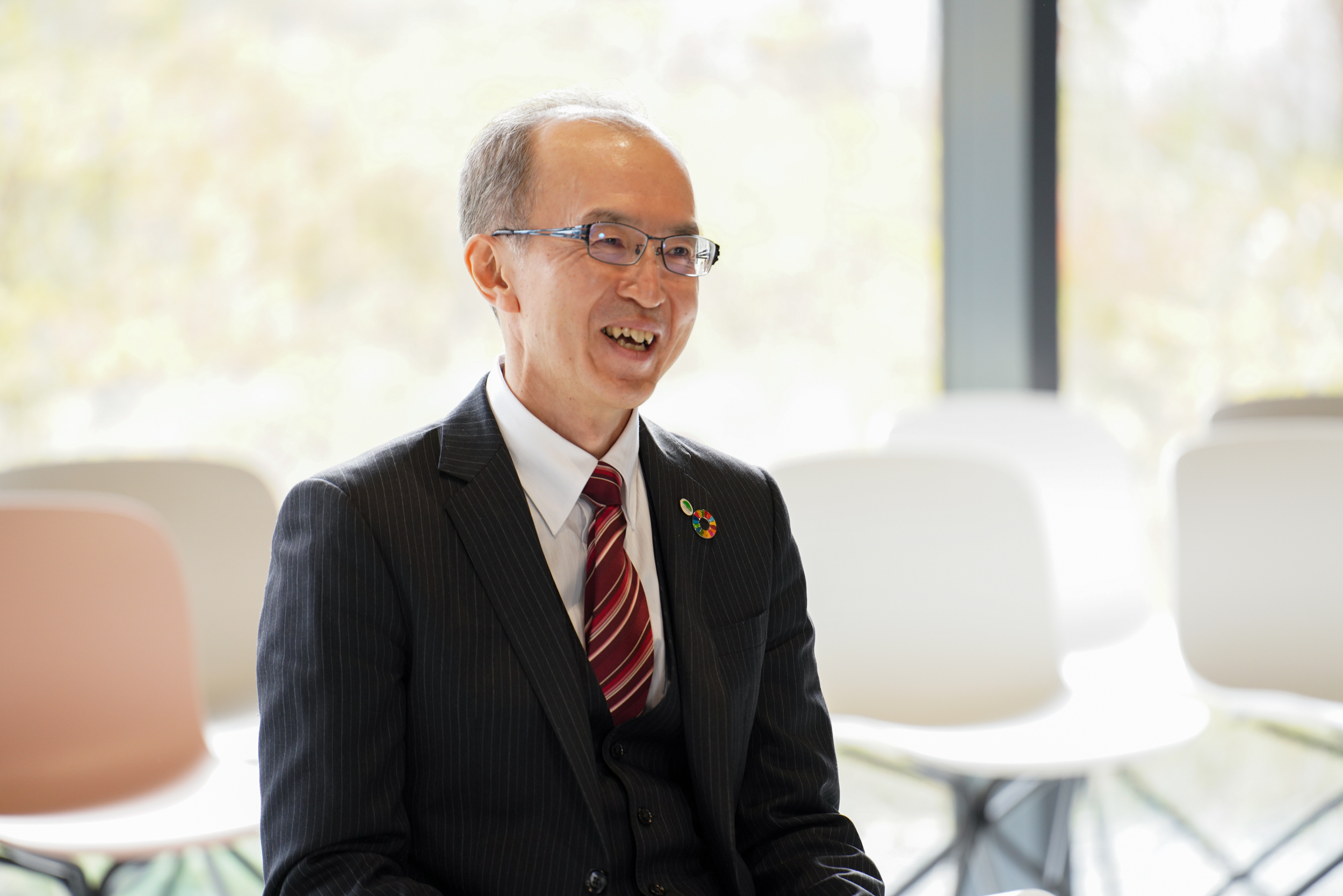
Mori:We developed a methodology to find insights into the future, which we call ”Kizashi” and have adopted it since 2010. People say what is happening amid the coronavirus pandemic is totally new to us, but from the Kizashi perspective, that is not necessarily true. Automation and contactless solutions have attracted attention, and originally a shift to such solutions was not expected to occur within the next ten years. However, it arrived very quickly, in a three-month period, accelerated by COVID-19.
Kizashi is meant to provide insights by capturing and delving into changes and emerging trends in people’s values, and it is different from predicting the future. Kizashi presents potential scenarios as to how the future could play out. Each scenario comes with specific data substantiating it and offers insights on “what ifs.”
A case in point on Kizashi-based deliverables; intriguing insights on environmental issues were presented ten years ago. That was the time when many countries in the world were beginning to focus on education on environmental awareness, and the Kizashi insights said that “environmental natives,” who received such education at a young age, might start questioning adults’ attitudes towards environmental problems. Then Ms. Greta Thunberg from Sweden spoke up and started her career as an environmental activist. It’s not the matter of whether not a Kizashi insight becomes a reality. Rather, our intention is to let you use it as a thought-provoking tool, giving you an opportunity to figure out what you need to do now responding to multiple future possibilities suggested by Kizashi. Given the current pandemic, we have started making a renewed effort on Kizashi research at all of our global CSI sites.
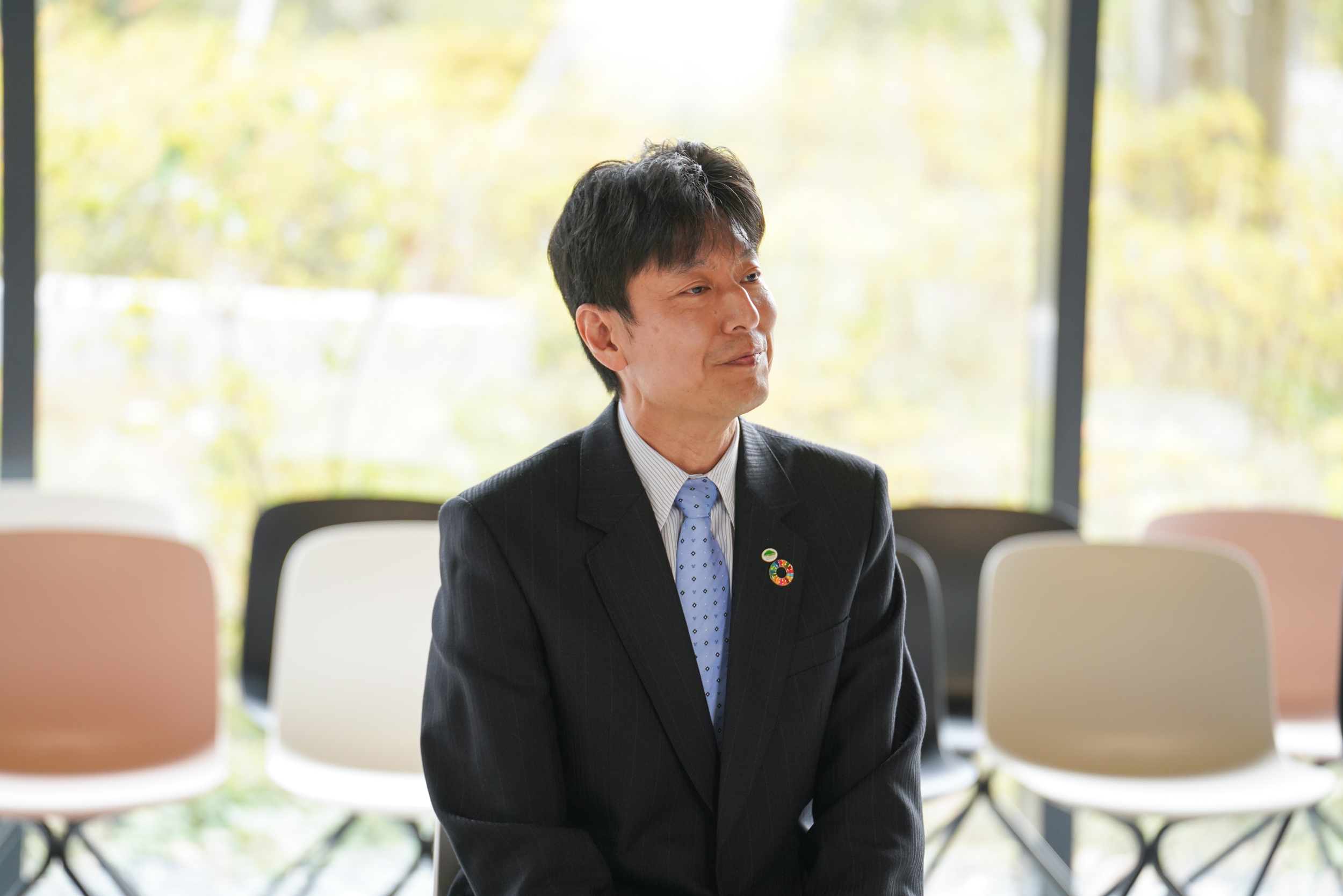
---- One of the objectives of Kyōsō-no-Mori is encourage open communication for innovation. What impact has the pandemic had on your research fields and activities?
Nishizawa:After the first state of emergency was declared across the nation in April 2020, digital researchers were asked to work from home, and the physical presence of people doing experiments at the laboratory was reduced down to 20% of the peak time. In such an extraordinary situation, some of our researchers used a bottom-up approach and embarked on a project seeking digital technology solutions to tackle the coronavirus crisis. One of the materialized ideas is to ensure social distancing by giving people guidance based on body motion measurements detected by sensors* and new ways of doing research are beginning to deliver some results.
*Case study: A system to motivate physical distancing by letting people enjoy visual presentations triggered by their walking motions
https://www.hitachi.com/rd/news/topics/2020/1130.html
Now, as of December 2020, our laboratory is being operated with a restriction on employee attendance; 10-20% of the digital scientists and 50% of the experiment researchers at the maximum are allowed to work on site. That makes shift calculation immensely complicated because in order to do a certain experiment under certain conditions, you need to determine who must come to work on which shift. Here we calculate our staff shift schedule with a new quantum-inspired computing technology called CMOS Annealing developed by Hitachi.
Mori:Collaborative innovation essentially is supposed to happen through face-to-face dialogues, but these days neither we nor our customers have been able to come to the laboratory in person. There are, however, a number of digital tools available, so we have been taking advantage of them to work together.
One notable change is that we have expanded our activities in a way only the digital approach can accomplish. Specifically, we organized an online workshop with 73 attendees including people from transportation operators, universities, and startup companies. The main theme of the workshop was “Mobility in the New Normal.” We have learned that, with lower barriers to participation, you can have discussions online involving a wide range of stakeholders, and that it is possible to get your message across and build empathy without sticking to face-to-face communication. We benefitted a lot from the experience, which opened up a possibility of a new format of workshops and ideation processes. At the same time, we learned lessons as well; even though connecting with people online has become easier and now we take it for granted, it is crucial to prepare for meetings, like explaining relevant background information to the attendees in advance.
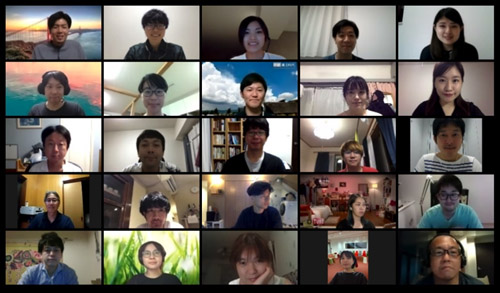
Snapshot images during a 3-part online workshop series on the theme of “Mobility in the New Normal.”
Digital is a tool, so having a perspective on how we can make the most of it is quite important. I believe that, though digital means, we need to tap people’s knowledge and wisdom for collaborative innovation as well as building empathy among people while overcoming constraints of time and location.
---- What do you think would be a new style of research/collaborative innovation in the “New Normal”?
Nishizawa:Research-related activities such as discussion, programming, writing reporta and papers, can be done remotely, but even now, experiments that need human intervention require people to be present at the laboratory. Down the road, some of the experiment tasks that used to be performed by humans may be replaced by computer-based simulations, and a limited number of researchers can attend to tasks requiring their physical presence at the lab. Taking it further, a time may come when AI and robotics will evolve to a higher level; you can implement a cyber-physical system (CPS) in a computer, where a Digital Twin can be deployed to run analyses, and when tasks are transferred back from the virtual world, robots can take over and physically perform subsequent tasks.
Nishimura: Meanwhile, the value of face-to-face communication has increased more than ever. Disruptive technologies such as quantum computing cannot be explored effectively without having tight discussions with various stakeholders in person. That is why an open forum like Kyōsō-no-Mori is meaningful.
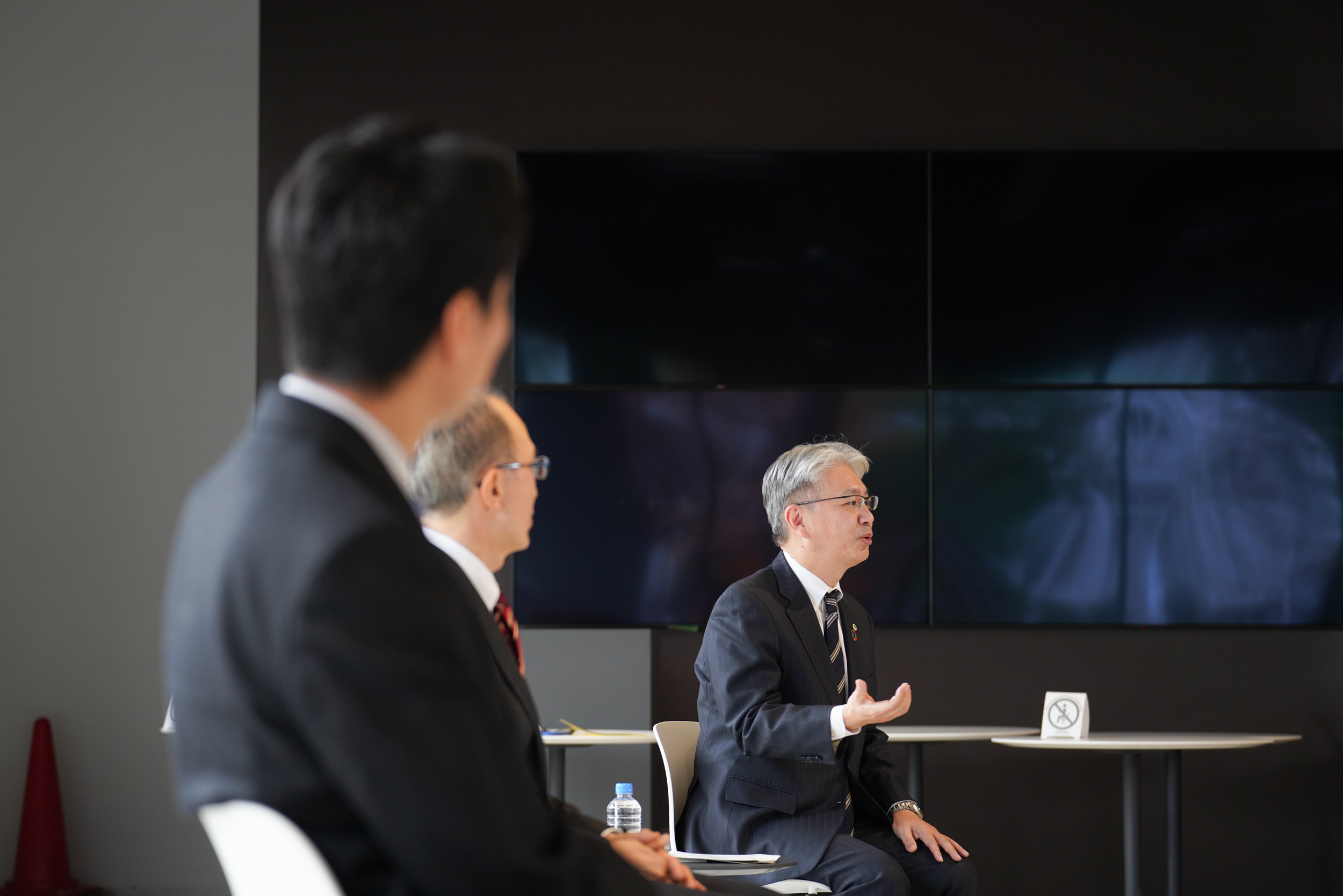
Mori:They say that we are living in a VUCA (Volatility, Uncertainty, Complexity, and Ambiguity) world. In this context, if you want to help improve people’s QoL (Quality of Life), you need to start looking at social issues from the perspective of people’s values and beliefs, so that you can initiate collaborative innovation efforts to make a difference.
Utilizing the Kizashi approach when raising questions enables you to broaden the range of solutions you deliver to solve the problems identified. Suppose you raise a question like this: “What kind of city would it be if its residents could continue living there without feeling lonely?” Then you use the Kizashi method to set specific requirements for such a city, while employing interdisciplinary insights to do so.
Mori:Technology should have a purpose to achieve. If, for example, the purpose is to make people’s lives more convenient, you need to keep thinking and asking questions about what you should do to make it happen. Otherwise, you’ll be stuck when you encounter a problem that cannot be solved by using optimization methods alone.
The key phrase here is “reflective questions.” ---- What do we need to do in the first place? And how should we do it? I believe that asking such reflective questions is going to be even more important in the Post-pandemic era.
In the coronavirus crisis, there was an emergence of the crowdfunding movement to help businesses such as shops and restaurants. People’s needs are shifting from the conventional “ownership” to “usership” in pursuit of convenience, and from there you can foresee that their mindset is leaning towards “engagement.” If and when people become able to be “engaged” in a way they are willing to help each other, then there will be some breathing room for them to start thinking in terms of what difference they can make in the world and their community. So, the “reflective question” approach will have significance.
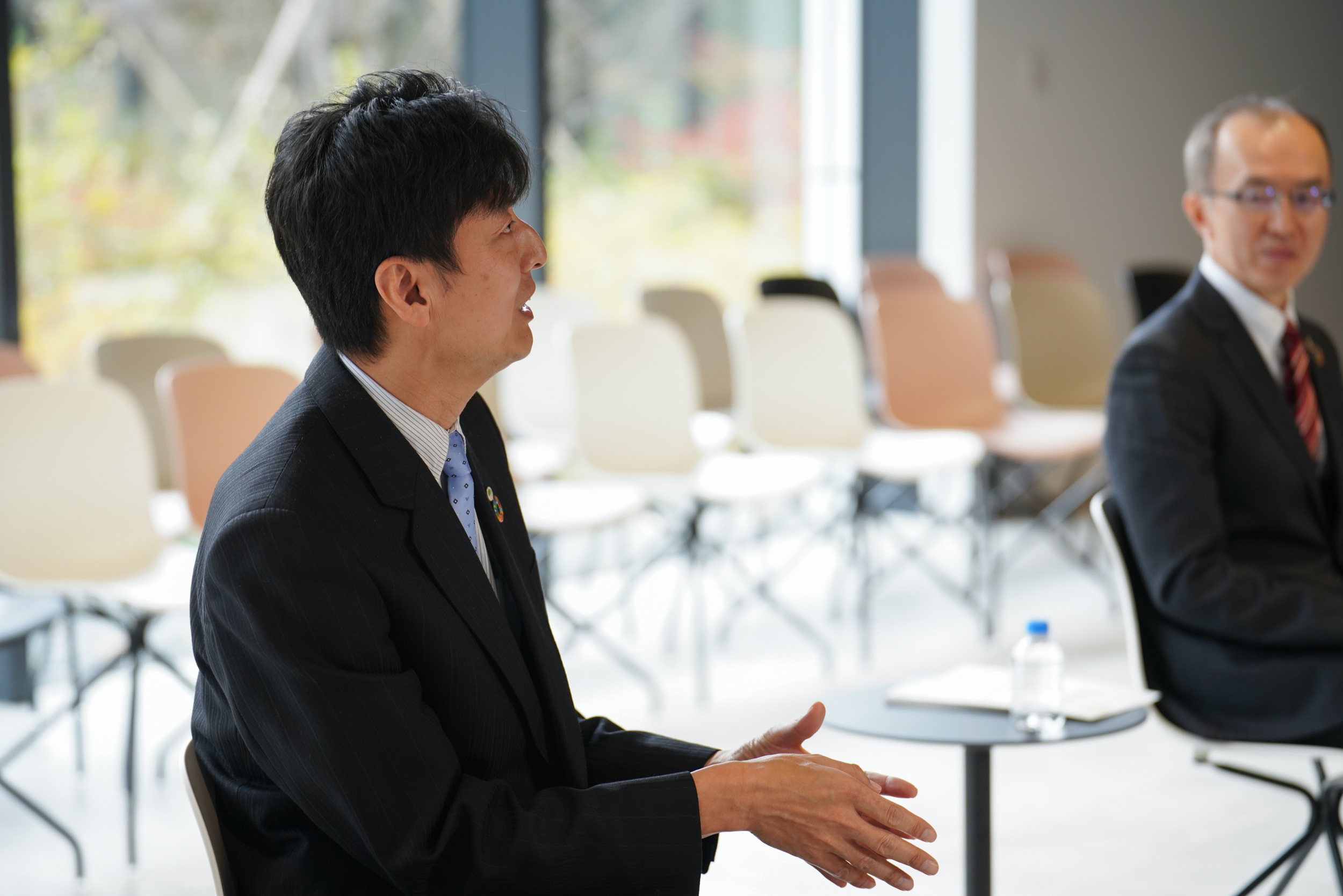
Nishimura:We live in an era where we are expected to strike the right balance in what we deliver while dealing with the different values of different people. When working with our customers, we can propose our ideas in a digital/virtual space, and raise a question, asking “Does this solution really accommodate what you want?” Sometimes the proposal might look somewhat different from their expectations, but we take it for granted, because different people want different things, and the situation varies from region to region, country to country. It is our job to understand such differences and create solutions tailored to customer needs. And that is also what society expects from us.
Nishizawa:Hitachi, as a business organization providing infrastructure, would like to offer services to help improve people’s QoL, beginning with services in the manufacturing and healthcare sectors. Our goal is to play a major role in transforming cities and society as a whole. That, I believe, is what we need to attempt at the Kyōsō-no-Mori.
Mori: As we try to solve social problems, our viewpoints seem to be gradually changing, shifting from a simple “optimization” perspective. We should revisit the benefits of digital technologies and combine them effectively so that we can move collaborative innovation forward. We need to figure out which technology should be adopted and how it should be applied, exploring various possibilities including but not limited to convenience-oriented solutions ---- that’s one of the things we’d like to pursue at the Digital Kyōsō-no-Mori.
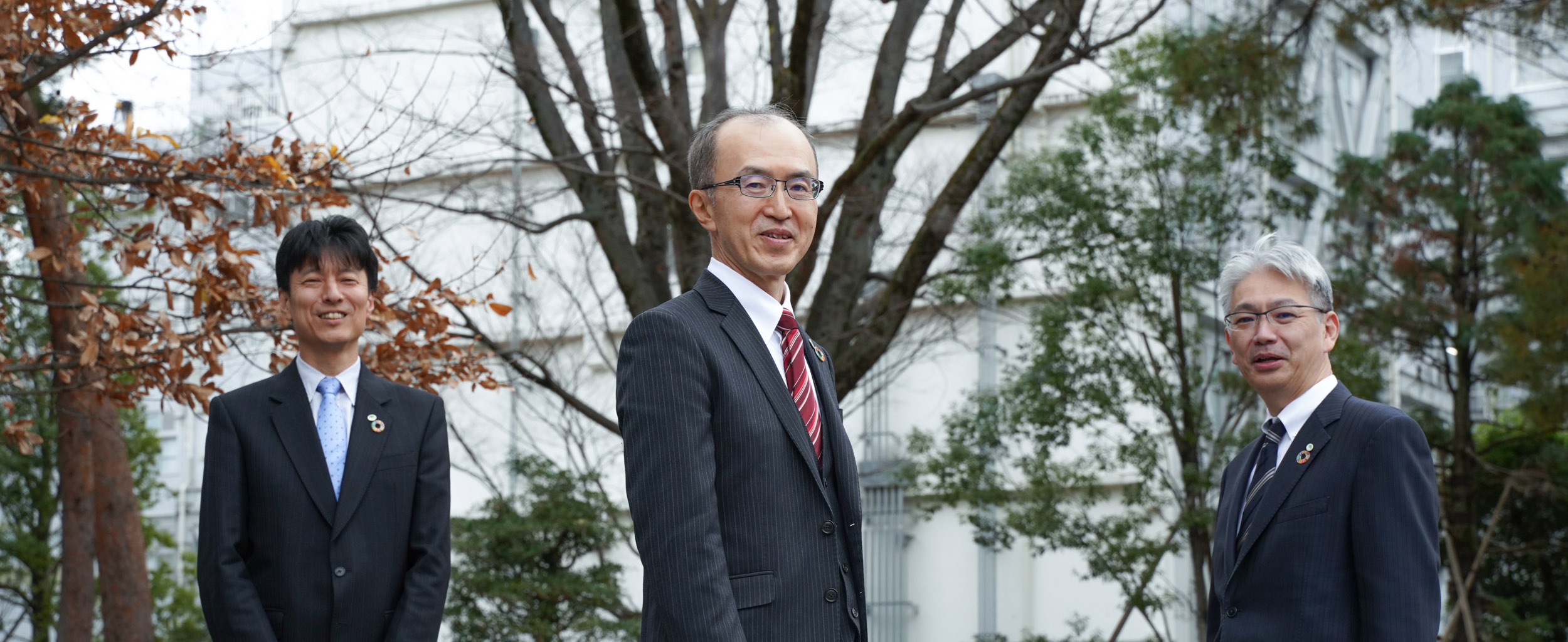 An outdoor terrace of the laboratory offers a space where people can work in a nature-rich environment.
An outdoor terrace of the laboratory offers a space where people can work in a nature-rich environment.
I have two recommendations: one technology book and one novel. Database systems are one of the most sophisticated and useful software tools we have, built on a theory that was first developed in the 1960’s. Database Systems: The Complete Book (Hector Garcia-Molina, Jeffrey D. Ullman, Jennifer Widom) is a comprehensive guide to theories of database systems, data processing, implementation as well as related topics.
My favorite novel is Sekai no owari to hādo-boirudo wandārando (Shinchosha Publishing) [English Translation: Hard-Boiled Wonderland and the End of the World] by Haruki Murakami. I was enormously touched by the main character’s decision and its future consequences, and I have been reading it over and over again since my younger days. The novel depicts a town surrounded by a high wall, as well as a forest and a pond. The landscape reminds me of that of our Central Research Laboratory, so I feel some kind of causality.
Itaru Nishizawa
Deputy General Manager, CTI
Hitachi, Ltd.
I recommend a Blu-Ray disc entitled Takuma Sato 2020 INDY500 CHAMPION No Attack No Chance. This is a story of Takuma Sato, a Japanese professional racing driver who won the Indianapolis 500 in 2020, his second victory in the event. The Indy 500 is one of the three most prestigious motor races. The video title alone is attractive, but the content is even better and thrillingly exciting. When Sato was competing in F1 races he was always too aggressive and didn’t get to perform consistently, but as he gained experience, he began demonstrating a great strength. He always looks for new ways of task execution through discussions with his team members and rivals. And during the event depicted in the video, while driving at a speed of 350km per hour, he was controlling race dynamics by monitoring and meticulously analyzing the momentum in the heat as well as his machine conditions. And as he got closer to the finishing line, he carried out an incredible attack and eventually grabbed the title. It was a dazzling moment with an impressive come-from-behind win. Every time I watch it, I am struck by his performance, feeling that this is how you should fight on the world stage.
Shinji Nishimura
General Manager, CER
Research and Development Group, Hitachi, Ltd.
I am interested in Japanese people’s way of thinking and behavior, so I tend to read Japanology books such as Shippai No Honshitsu : Nihongun No Soshikironteki Kenkyū (Chuko Bunko) by Ryōichi Tobe and Gyakusetsu No Nihonshi (Shogakukan) by Motohiko Izawa, and think about the background to our daily habits and about the cultural differences between Japan and other countries. Meanwhile, I’d say my way of thinking has been greatly affected by Shin'ichi Hoshi, a Japanese novelist best known for his "short-short" science fiction stories. While his short stories are quite interesting, I particularly like his essays in which his thoughts are well expressed. I also read his biography written by Hazuki Saisho, entitled Hoshi Shinichi – Sen Ichiwa Wo Tsukutta Hito (Shincho Bunko) and I was deeply inspired by the story of his life.
Masakatsu Mori
General Manager, CSI (concurrently)
Research and Development Group, Hitachi, Ltd.